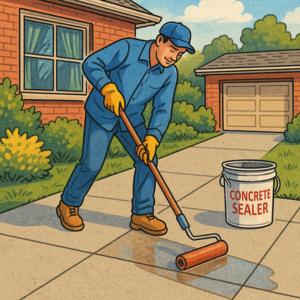SEALING
 |
|||

Concrete Sealing involves applying a protective layer to concrete to prevent damage from moisture, chemicals, freeze-thaw cycles, and abrasion. Sealers fall into two main categories:
Penetrating sealants and Surface (Film-Forming) Sealants. The choice of sealer depends on whether the concrete is fresh or cured, the environment, the level of wear, and any aesthetic considerations.
Penetrating Sealants soak into the concrete and chemically react with the substrate to form a water-repellent barrier. They do not form a surface film and typically do not change the concrete’s appearance. These sealers are highly breathable, allowing moisture vapor to escape while preventing liquid water from entering.
Common types include Silanes, Siloxanes, Silicates, Siliconates, and Fluorinated compounds. They offer long-lasting protection, often five to ten years or more, depending on the type and conditions. These sealers are most often used in outdoor applications like driveways, sidewalks, parking decks, and bridges where protection from weather and deicing salts is important.
Because they do not alter the surface finish or color significantly, penetrating sealers are ideal for users who want protection without changing the look or texture of the concrete. They also have a low risk of creating slippery surfaces.
Surface (Film-Forming) Sealants create a physical film over the concrete to block moisture and contaminants. These Sealers include acrylics, epoxies, and polyurethanes. They vary in appearance from matte to high-gloss finishes and often enhance the color of decorative concrete.
These sealers are commonly used on stamped, stained, or polished concrete floors, patios, and countertops. While they can significantly improve surface appearance and stain resistance, they are generally less breathable than penetrating sealers and may trap moisture if applied over damp concrete.
Sealing Fresh Concrete
Sealing fresh concrete usually focuses on moisture retention during the curing process and early surface protection. This is often done within the first few hours to days after Placement using Cure-and-Seal products. These are usually acrylic-based compounds that help retain moisture for proper Curing while also offering some protection against surface staining or dusting.
Cured Concrete
Once concrete has cured—typically 28 days after placement—it can be sealed with long-term protective products. The surface must first be cleaned thoroughly and, if needed, mechanically prepared (etched or ground) to ensure proper adhesion or penetration of the sealer.
Shining a light on over 80 Construction Categories, with unlimited potential for Sub Categories - Watch our Community grow!

